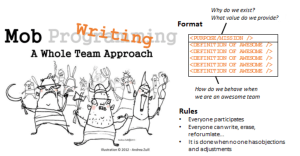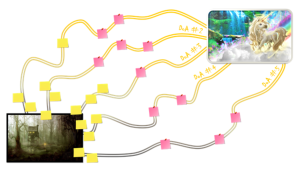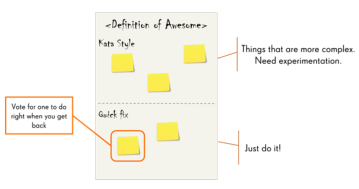In this post I’ll describe some exercises that can be used when kicking off a new team or if you want to get an existing team aligned on how it wants to work and what value they provide to the organization.
The package contains of the parts below. Depending on how far you want to take it and how you work with improvements you might want to settle for the first two parts.
- Setting the stage and warming up
- What is an awesome team?
- Appreciative inquiry
- Mob writing: Mission and Definition of Awesome
- Are we there yet? Identifying the current condition and obstacles.
- Identifying candidates for first steps in reaching the definitions of awesome.
All of these usually take about 3 hours to get through (including breaks).
Setting the stage and warming up
The first thing you want to do is to talk about why you are there (you probably already touched on that in the invite) and why it is important that the whole team participates.
After that you will want to get people in the right mindset with some warm up. Especially if this is the first thing you do in the morning.
What is an awesome team?
In this part you can throw up examples of teams and ask the group if they are awesome or not. Discuss why or why not. You can find your own but here are some examples and points that you can discuss.
- The A-team
Cross functional
Have clear missions
Help each-other to solve tricky problems
… and like the A-team all teams need a crazy helicopter pilot. 😉 - Fellowship of the ring
A clear mission
Not that aligned on how to reach that mission - Orchestra or a rock band
Specialists
Sound better when they work together
Practice really hard individually on their skill but also need to play and practice with other types of competences. - Sports team (in this particular case Chelsea when they won the Champions league)
This picture tells the story about a sports team that were the underdogs throughout the kick out phase but managed to get to the finals. In the finals they met Bayern Munich and were again underdogs. In the end Chelsea had done all their substitutions and a defender got injured. Fernando Torres (a forward) took a place in the defense of the team. He went outside of his expertise to to what the team needed at the time and in the end the team won after overtime and penalties. - People working out at a gym (compared to a sports team)
From the outside it might look like everyone is really busy and working on the same kind of thing (like a sports team). In reality there is little to no cooperation and everyone is only focused on their own goals/agendas. Do the team participating in the workshop want to be people working out at a gym or a sports team?
Appreciative inquiry
This warm-up is a segway into the third part – Mission and Definition of Awesome. The purpose being that the team members start telling each other what they think is working well from their perspective.
This exercise builds on appreciative inquiry where you only focus and talk about what is working well or what could be working well.
Stage 1
Ask the participants to write on post-its what is working well today. One thing per post-it. After about 3-4 minutes you ask the participants to present their post-its one by one and talk about what they have written.
Stage 2
Ask the participants to imagine that you have created a time machine. You all step through this time machine and travel into the future. Depending on what context you might want to select different amounts of time but it can for instance be a year into the future. In this future you walk over to the office and meet your future selves. They say that it has never been this great. Everything is working perfectly. You are productive, happy etc. Ask the participants to write on post-its what their future selves tell them and what they see around them. Present as you did in stage 1.
Mob writing: Mission and Definition of Awesome
The next part is to as a group agree on what the  purpose of the team is (Mission) and
purpose of the team is (Mission) and
what identifies them when they are working really well (Definition of Awesome) is.
Start by explaining the format
and the rules:
- Format
- You will have one or two sentences describing the teams mission. Try to make it snappy.
- You will have five (not more!) statements describing what identifies the team when it is working really well. The team can draw inspiration from the post-its on the wall from the previous exercise as inspiration.
- Rules
- Everyone participates Everyone can write, erase, reformulate… It is done when no one has objections or adjustments.
Invite everyone to the whiteboard and hand out pens. What usually happens is that people start adding statements without getting questioned. The magic happens when all five slots are full. Then the teams needs to start communicating, arguing and agreeing on what they think is important. Try to give the team as much room as possible but if discussions derail ask the team to move on the something else and then go back to pick up the statement discussed later on.
When the discussions are cooling down you can enter the group again and point at the first statement and ask if everyone agrees. Thumbs up = agree, thumbs to the side = could be improved, thumbs down = this is not ok.
When the team is in agreement move on to the next part.
Are we there yet? Identifying the current condition and obstacles.
 So now we have identified where the team wants to be – the Definition of Awesome. Let’s figure out how to get there. Here we use the classic coaching format of identifying the target condition (Definition of Awesome), current condition, obstacles and actions/improvements. In the picture to the right the rainbows and unicorns is the definition of awesome. This is where the team wants to be. The five roads represent the five statements and the swamp is where the team is today.
So now we have identified where the team wants to be – the Definition of Awesome. Let’s figure out how to get there. Here we use the classic coaching format of identifying the target condition (Definition of Awesome), current condition, obstacles and actions/improvements. In the picture to the right the rainbows and unicorns is the definition of awesome. This is where the team wants to be. The five roads represent the five statements and the swamp is where the team is today.
Step 1: Current condition
In this step the team writes post-its describing the current condition connected to each track. These are represented by the yellow post-its on the picture.
Step 2: Obstacles
Here the team looks at what is preventing them from reaching the target condition. These are represented by the pink post-its.
First steps
 In this part the team will identify how Awesome can be reached. We use a rotating flipchart style where you set up five flip charts or Magic Charts spread out around the room. Split the team and spread out among the charts. On each chart you talk about one of the definitions and what you can do to reach it. If the idea is complex you might want to use a Kata style approach – we put them on the upper part. Actions that are quick and straight forward are put in the bottom.
In this part the team will identify how Awesome can be reached. We use a rotating flipchart style where you set up five flip charts or Magic Charts spread out around the room. Split the team and spread out among the charts. On each chart you talk about one of the definitions and what you can do to reach it. If the idea is complex you might want to use a Kata style approach – we put them on the upper part. Actions that are quick and straight forward are put in the bottom.
After about 5 minutes it’s time to rotate and you go to the next chart and discuss that. After four rotations everyone should have visited each chart/definition.
To have something concrete to bring back and to get started when right away when you come back to the office it can be a good idea to vote on one quick fix per chart to do right away. Assign people to take responsibility for each quick fix that are voted on.
Following up
After these exercises the team will have a lot of materials to drive improvements from. Bring it all back and try to make as much of the results visibal and present near the team. If you aren’t already using a Kata-style approach to improvements perhaps you can find some inspiration in this blog post: Toyota Kata – an alternative to retrospectives by Håkan Forss.
However you do it, the important thing is that you continue to work with the results so the time wasn’t wasted and just a nice experience in a conference room somewhere.
Summary
This set of exercises have proved to work quite well for me. Off course you might want to tweak them to fit the teams needs or add other exercises if you do this as part of a full day.
I hope this post was helpful and don’t hesitate to comment below or reach out to me if you have any questions or want help in facilitating a workshop.
Good luck!